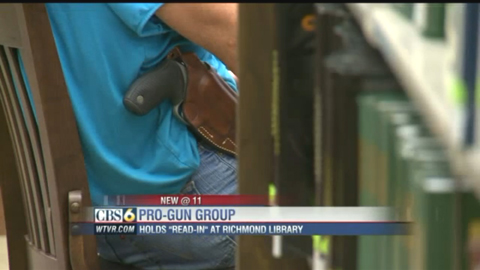
It’s been just over a year since 26 people were shot to death shortly after the school day began at Sandy Hook Elementary School in Newtown, Connecticut. As it often does in the wake of a mass shooting, the national dialogue post–Sandy Hook about the availability of firearms predicted that the murder of 20 children and six educators would prompt stricter gun controls. That has not proved true, and libraries have become embroiled in the debate more than ever.
The complexities involved are exemplified by a court case in Michigan, Capital Area District Library v. Michigan Open Carry (CADL v. MOC). The library sued MOC in 2011 for conducting open-carry protests inside CADL despite firearms being forbidden there. MOC prevailed in the lower courts, and the state supreme court declined to hear CADL’s appeal on November 21, 2013. The case tested a key issue: Do libraries have the right to declare themselves a gun-free zone? In Michigan at least, the answer is apparently no.
A patchwork system
Diana Gleason, head of public services at the University of Idaho College of Law Library in Moscow, was so intrigued by CADL v. MOC that she conducted a nationwide survey of state gun laws to answer the question, “If they can do this in Michigan, where else can they do this?” Her findings appear in Public Libraries Quarterly (vol. 32, no. 4).
Gleason describes a patchwork of state laws regulating the open carry of firearms. However, there is now a legislative consensus nationwide that concealed carry is legal as of 2013, when Illinois became the 50th state to enact a law permitting the concealed carry of firearms by licensed gun owners.
Whatever local law permits, the key issue for libraries is whether a library can forbid patrons from bringing guns onto its premises should it choose to ban firearms.
“People may feel better in some states to have guns in their libraries,” says Gleason. Pro-gun rallies at the Baldwin Public Library in Birmingham, Michigan, this past summer and Richmond (Va.) Public Library in 2012 (see photo above) show how some see the presence of guns as a deterrent to violence.
As of mid-November 2013, only the District of Columbia and five states (Florida, Illinois, New York, South Carolina, and Texas) regulated open carry so strictly that gun owners could bear loaded firearms in a visible manner only when traveling to and from, and engaging in, hunting.
“The most important factor is whether states have preemption [to override local ordinances],” says Gleason. “If a state doesn’t have it, then the libraries in that state can probably regulate guns on their property. If the state has preemption, the next most important factor is whether there is an exception in the law for libraries.”
In Illinois, which has preemption over local statutes, the new concealed-carry law specifies public libraries as gun-free zones, along with public buildings, daycare centers, parks, playgrounds, and bars. “We fought hard on that one,” says Robert Doyle, executive director of the Illinois Library Association. Public libraries in Illinois must display a gun-free-zone sticker at the entrance that cites state law.
The law makes Illinois the only state to declare public libraries to be gun-free zones—a distinction previously held by Kansas and relinquished by its legislators in 2013. Kansas passed a law last year that allows licensed gun owners to conceal-carry firearms into any public building that lacks security guards and metal detectors.
The statute prompted the board of the Topeka and Shawnee County Public Library (TSCPL), which bans guns, to ask the state attorney general for a four-year extension of the library’s current patron-behavior policy while it seeks an almost $250,000 millage to install security gates and hire guards. Quentin Martin, the only TSCPL trustee to oppose extending the gun ban, inadvertently expressed the reasoning behind the law in the October 27 Topeka Capital-Journal even as he explained his vote: “All active shooter incidents have occurred in gun-free zones.”
Seattle Public Library, which also had a longstanding gun ban, was forced by a 2012 Washington state court decision to replace it with a policy barring “carrying, exhibiting, displaying, or drawing any firearm in a manner that demonstrates an intent to intimidate another or that warrants alarm for the safety of other persons [or] possession of any other dangerous weapon.” The new policy went into effect in October 2013.
For libraries in states that preempt local ordinances and rules in conflict with state law, Gleason says that their best bet may be to “ride on the coattails” of the Gun-Free School Zones Act of 1990. The federal law prohibits firearms in K–12 buildings, Gleason says, because “schools are a sensitive place where the public and children are present.” The same logic should apply to public libraries, she says.
“I would think, as a matter of policy, that it would be important to librarians and to patrons to be in a place where you can pursue your First Amendment right of intellectual freedom in a safe and nonthreatening manner,” says Gleason.
UPDATE Feb. 21, 2014: The Gun-Free School Zones Act of 1996 is the correct enactment date of the current federal law. The 1990 act was overturned in 1995 by the US Supreme Court as unconstitutional under the Commerce Clause. Congress subsequently added language that limited its enforcement to a gun that “has moved in or otherwise affects interstate commerce.”

![Scott County (Ky.) conducted a simulation of an active shooter event in their library, producing a video. (Photo: Georgetown [Ky.] Police Department)](https://americanlibrariesmagazine.org/wp-content/uploads/2015/06/activeshooter2-300x222.jpg)
